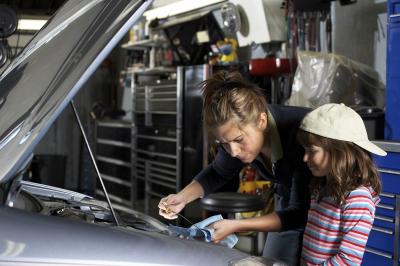Automobiles are highly complex machines with a variety of interdependent systems. As such they require periodic maintenance to perform at their peak efficiency. This periodic maintenance is usually called a tune-up. This is especially important in today's world where fuel economy and emissions are so important. Depending on the type of vehicle you are driving, the kind of driving you do and the age of your car, the time between tune ups can vary. Knowing when to perform one or take your car to the shop can save you time and money.

The first place to check your tune-up schedule is in the owners manual of your vehicle. The maintenance schedule should be clearly listed along with the typical tune up items: spark plugs, spark plug wires, ignition components and adjustments. Try to maintain this schedule.

Sometimes a vehicle needs a tune-up more often than the owner's manual states. This can be true if the vehicle is driven in extreme conditions or if the mileage is getting high. In this case, listen to your car. Difficulty starting, hesitation on acceleration, increased tailpipe emissions (smoke) or poor fuel economy can all be signs that a tune-up is needed. Fuel economy can be easily checked periodically. Simply fill the gas tank all the way up. Then record the mileage or reset your trip odometer to zero. Drive until near empty and refill to full. Record the number of gallons needed to fill the tank and divide by the miles driven since the last fill-up. This will give you miles per gallon.

Newer automobiles have electronic ignition and fuel injection mandated by federal government standards. Only with the use of continuous computer control can these standards be maintained. Older vehicles use carburetors and mechanical ignition systems. Both carburetors and mechanical ignition systems require more frequent maintenance than modern systems.
Mechanical IgnitionOlder ignitions system, generally those made before the mid-1980s, use an ignition system with points and a condenser. These points wear quickly and also tend to erode spark plugs more rapidly. Worn points are indicated by hard starting and hesitation on acceleration. The points gap needs to be checked every few thousand miles, especially if you do a lot of stop-and-go driving. The vacuum and mechanical spark advance should also be checked at this time.
CarburetorsCarburetors have little if any automatic control systems so must be continually adjusted. The systems that tend to get out of adjustment quickly are the automatic choke, idle, and mixture. If your car has a carburetor and is experiencing trouble starting or idling when cold, it may very well need adjustment of the choke. Difficulty idling when hot may well indicate a mal-adjusted idle screw. Blue smoke out of the tailpipe is often an indication of an excessively rich mixture, while knock may be a sign of a lean mixture.

Knowing what to listen and look for is the surest sign of when a car needs a tune-up. So learn to listen and look for these signs and you will save money and have a better experience with your mechanic when the time does come to take the car in for a tune-up.
